Standing on the edge of the cliff, the medieval inhabitants of Predjama Castle, locally known as Predjamski Grad, must have felt invincible. However, just like any asset that attracts attention, Predjama Castle carved into a mountain in southwest Slovenia experienced the real-life game of thrones. The rulers were changing over centuries, yet the largest cave castle in the world remained.
In 2015, Guinness Book of World Records recognized the uniqueness of Predjama Castle
In the Middle Ages, fairytale castles in Europe were springing up like mushrooms. Those fairytales had thousands of faces. From Neuschwanstein Castle in Bavaria, which inspired Disney’s vision of Sleeping Beauty’s home, to Bran Castle, Dracula’s hangout in Transylvania, these magnificent buildings fed a variety of storylines. Some were stimulating fantasies, others – fear.
With over 500 castles in Slovenia, the small country squeezed between the Alps, the Adriatic Sea, and the Pannonian Plain, almost caught up with Wales, the European castle champion.
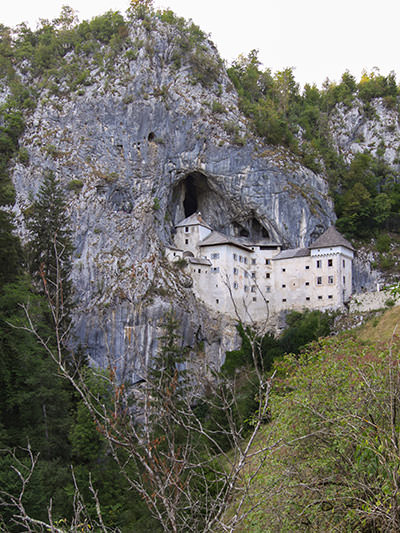
But beyond the quantities, the castle integrated into a cave above the tiny village of Predjama, in the already fascinating municipality of Postojna, is unique in the world. In 2015, the Guinness Book of World Records recognized Predjamski Grad as “the largest castle built in the entrance to a cave”.
This spectacular höhlenburg, a one-of-a-kind grotto castle, is a product of a particular encounter between nature and architecture. It inevitably raises a million questions, answered by a history of facts and fiction blended together.
I have visited Predjama Castle twice, once from the outside, and once from the inside. In this Predjama Castle guide with photos, learn all you need to know about Slovenia’s most extraordinary building. Find out how to see Predjama Castle, and grab crucial information necessary for your visit. Welcome to Predjama!
While Predjama Castle could resist year-long sieges, the most visited castle in Switzerland fell after a 3-day attack. Learn more about Chillon Castle, an island castle that served as an inspiration even for "The Little Mermaid"!
Why is Predjama Castle famous?
From primitive humans looking for a hideout from snow and rain to modern men who celebrated life itself (such as the fisherman that built the Agios Stefanos chapel in Greece), caves were always seen as shelters. Okay, sometimes also as homes of beasts that demand virgin girls for a snack. But in general, the danger was mainly outside the cave.
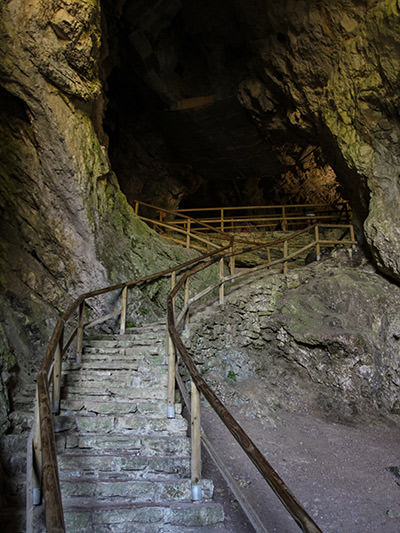
Archaeologists have found evidence that humans lived in Predjama caves since the Stone Age. People of the Middle Ages followed the example of their ancestors and decided to build a castle in this hardly accessible location.
Perched halfway up on a 127-meter-high limestone cliff, under a natural rock arch, the dramatic structure was built and rebuilt, surviving, being destroyed, and resurrecting until modern times.
Today, serving as a national museum, Predjama Castle is one of Slovenia’s most visited tourist attractions.
Its secret tunnels, legends, and mere location in the karst landscape the region became known for, provided fascination to, firstly, many tenants, and then even more numerous visitors.
The karst landscape got its name after the Kras region, the Slovenian plateau between Trieste, the Adriatic Sea and Vipava Valley. The Romans gave it the Latin name Carsus, Karst in German. As the prime example of a water-soluble rock formed over centuries, it became a generic term for all limestone landscapes.

Cave under the Karst castle
The castle of Predjama would be a masterpiece of architecture already as a fortress in the middle of a rocky wall. But there is an even larger surprise in the belly of the mountain.
The enormous Cave under Predjama Castle reaches a length of 14 kilometers, as the second largest in the country. The Slovenian underground champion, Postojna Cave, is the first neighbor, only 9 kilometers away.

Predjama Castle cave was the place to park your horse in the Middle Ages, but today, it is home only to a colony of bats. Their hibernation is the main reason why the cave is closed to visitors in winter.
From May to September, tourists can enter the first 700 meters of the cave, but those who seek adventure can challenge themselves with an even deeper trek.
Unlike Postojna Cave, the cave under Predjama Castle is not illuminated by electricity. One enters its tunnels equipped with a flashlight, which provides an authentic experience of early cave explorers.
You might love quirky architecture, but a Vietnamese architect inspired by caves and trees could still raise your eyebrows. Her hotel is not named Crazy House for no reason!
Predjama Castle history
Who built Predjama Castle, when, and why?
Even if its exterior suggests a Renaissance origin, there is an even older history of Predjama Castle. It was first built in Romanesque/Gothic style, probably in the late 12th or early 13th century, on the site of a tiny settlement embedded in the cave since the end of the first millennium. The castle was first mentioned in historical records in 1274.

Just like with other monumental buildings of the period built on the mountain rock (such as Mount Athos monasteries in Greece, or Lalibela churches in Ethiopia), the church money was behind the castle of Predjama too.
The Patriarch of Aquileia, the influential ancient city of northeastern Italy, ordered the construction of an unconquerable fortress. The sharp-drop location was promising difficult access, thus guaranteeing greater protection.
Over time, the patriarchs would be giving Predjama Castle into possession of a variety of knights. And one of these will become a legend.
Erasmus of Lueg
The fact that stories portray Erasmus of Lueg (Erazem of Predjama or Erazem Predjamski in Slovene) as a noble knight or as a cruel bandit tells us that he was right in between the major powers fighting for dominance.
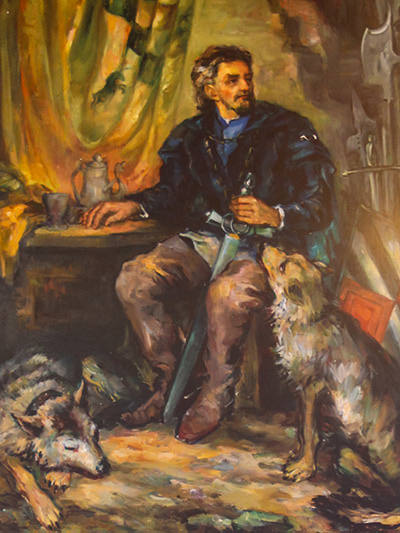
One storyline, possibly projected to belittle his historical significance, portrays Erasmus, the son of the Imperial Governor of Trieste Nikolaj Lueger, as a baron robber. The Slovene version of Robin Hood would supposedly oppose the tax system of Duke Ivan the Wolfsnout by stealing from the rich and providing for the poor.
The other storyline puts Erasmus Lueger at the center of a conflict between Austria and Hungary. Andrej Baumkircher from Vipava, Erasmus’s best friend, was one of the knights who changed sides, leaving the Habsburg Monarchy and joining the forces of the Hungarian king Matthias Corvinus. Austrian emperor Frederick III got Andreas killed, which obviously affected Erasmus. At a reception in Vienna, while defending the honor of his friend, he murdered one of the emperor’s relatives and fled to Predjama Castle, the strategic outpost for Hungarian cavalry advancing west.
Both stories end seeing the Slovene burgrave besieged in the castle, testing its impregnability. With a water source at disposal and secret tunnels leading out of the mountain and providing access to food and other supplies, the siege lasted longer than a year.

Erasmus of Lueg was laughing at the enemy’s attempts to starve him out. To show off, he supposedly bombed them with fresh cherries Vipava Valley is famous for. On some occasions, he allegedly targeted his confused foes even with luxury products such as roasted pig, fish, and – ox!
Successors of Erazem Predjamski
Erasmus of Lueg lost his life in Predjama Castle as a 34-year-old. The siege came to an end when one of his servants betrayed him. The invaders bribed the servant to light a candle on a window, which would give a signal that his master was in a vulnerable position. Erasmus was shot by a cannonball at the spot, and according to derogatory rumors, the spot was – his toilet seat.
Yearlong attacks did not only end with the death of Erasmus Lueger but also left serious damage to the “impenetrable castle”. The emperor gave it to the Oberburgs, then to the Purgstall family, who immediately started the reconstruction. However, their efforts were in vain, as a massive earthquake hit Predjama in 1511, and practically destroyed the castle again.

In 1567, the castle of Predjama was leased to the Cobenzl family, and they reconstructed it in Renaissance style in 1570. It pretty much resembled what we can see today. But in the days, Erasmus’ evacuation route also served as an entrance point for sneaky thieves. The baron decided to brick the “secret” passageway which was connecting the castle with the neighboring villages. Cobenzl family was Predjama Castle’s owner until 1810.
The 19th century saw the Austrian aristocracy moving into the castle. The first heir was Count Michael Coronini von Cronberg. In 1846, Prince Alfred von Windisch-Grätz took over and used the fort as a hunting lodge.
After the Second World War, the Socialist Federal Republic of Yugoslavia was founded, and the state authorities confiscated the building. Now nationalized, the castle was turned into a museum, today owned by the Republic of Slovenia. Nobody lives in Predjama Castle anymore. Well, unless you count some visiting animals and – ghosts.

Is Predjama Castle haunted?
In 2008, the production team of “Ghost Hunters International”, the TV reality series investigating the sites of paranormal activities, visited Predjama Castle and did their best to portray it as a spooky and ominous place.
With so many residents that lived (and died) here, would it be possible that some souls got trapped among the rocks, never to leave? The SciFi Channel explorers posed this question seriously, aiming to use scientific methods to discover the ghost of Erasmus or any other talkative spirit hanging out in the dark castle corridors.
In “Tortured Souls”, episode 13 (ominous, of course!) of the first season of GHI, the investigators centered their search in the supposed torture chamber, as well as the caves underneath.
They claimed to have detected unnatural magnetic fields, as well as unusual sounds such as footsteps, knocking, and mysterious voices behind the walls. Were those really manifesting spirits of Erasmus, or potentially people who died during the 1511 earthquake?
The evidence is, like usual in such cases, inconclusive. There is a lot of “Did you hear that?” moments in the episode. The researcher asked the ghost: “Do you know you don’t have to be here anymore?” The same guy then claimed: “I’d swear I heard ‘I know’”.
The Ghost Hunters episode doubled as free marketing, propelling Predjama Castle to the list of the most haunted places in the world (where haunted castles are not the least terrifying).
The ghost is hungry
The clearest recording of what the American ghost hunters call an electronic voice phenomenon in Predjama Castle sounded like: “Look!”

Anticipating the issue that medieval knights and peasants certainly did not speak modern English, the ghost specialists rushed with an expert explanation: “We speak English, but it seems they have a basic understanding.”
Of course, if there would have been Croat on the team (me, for instance), I could have said that what sounds like ‘look’ in English was actually a Croatian word for ‘onion’. Would that mean that the ghost of Erasmus was still trying to keep the castle supplied with food?

Jokes aside, the Ghost Hunters International gave a wannabe-serious explanation of how the voices of the past could have gotten trapped in Predjama Castle.
With alchemic zeal, they explained that the basic materials these cave rocks are made of are salt (one of the researchers actually licked the stalagmite to confirm it), water, iron, and quartz. Supposedly, that’s a recipe for a mountain as a battery! Now, did I say ‘jokes aside’?
To quote one of the ghost hunters: “I’ve been to many spooky places, but never heard anything like that before.”
Predjama Castle’s ghostly appeal is just another valid reason to make a stop here on your road trip through Slovenia.
A man in Indonesia also heard voices, and they told him to build an unusually shaped temple. Read more about the Chicken Church, the most bizarre architecture venture on the island of Java!
Predjama Castle in movies
The SciFi reality (and if that’s not an oxymoron, what is?) was not the only production that brought the Slovenian castle to TV and cinema screens.
One of the first movies that recognized the potential of Predjama Castle as a film location was “Zorikan the Barbarian”. Roberto Mauri directed the not-really-successful 1964 Italian adventure on a Christian-barbaric struggle over a stolen religious relic. If you really must, you can watch the movie here.
Much more accomplished in depicting the battle over a mysterious treasure guarded by monks was the “Armour of God” (1986). With Jackie Chan in the main role and the role of a director, Predjama Castle became a focal point of the cult classic action movie. Slovenia was also the place where Jackie Chan almost died. The actor famous for doing his own stunts had to jump off of a cliff and grab onto a tree. But the branch snapped, and Chan fell from a height of 5 meters. He cracked his skull, with a piece of bone damaging his brain, resulting luckily only in some hearing loss in his right ear.
In 1988, Peter Vezjak directed a music video for Laibach at Predjama Castle. The famous Slovenian avant-garde band made the cover of “Sympathy for the Devil” by Rolling Stones, and the fortress served well as a filming location for the band’s sinister sound.
The Slovenian castle also made an appearance in the South Korean romantic drama series “Black Knight” (2017). The script follows a businessman and a travel agent who spent their childhood together but got separated, reuniting as adults in Slovenia, with Predjama Castle playing its essential part. The love story became a hit on Korean TV, seeing a surge of visitors to the Predjama Castle home country.
Was Predjama Castle in Game of Thrones?

With its unique appearance and mythical aura, Predjama Castle seems to be a logical set choice for “Game of Thrones”, HBO’s successful fantasy drama.
While the castle didn’t make it to the screen, it did enchant the author of the novel George R. R. Martin in 2011.
After visiting Predjama Castle at night, he called it “amazing” and “an astonishing fortress-in-a-cave”, worthy of modeling a Westeros castle on it in his “Song of Ice and Fire” book series.

Nevertheless, the true GoT fans already found connections between the world of Slovenian and fictional knights.
In the series, Tyrion shot Lord Tywin Lannister while he was sitting on the least noble throne – the loo.
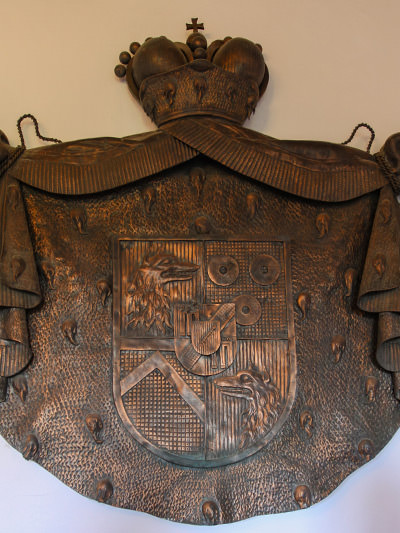
Besides the similarity with Predjama Castle legend of the death of Erasmus, the viewers also noticed the resemblance between House Stark’s sigil and the one of the Windisch-Grätz family, both starring a wolf.
If these coincidences did not satisfy your desire to see Predjama Castle in some TV fantasy, the good news is behind the corner.
In 2022, the castle was closed to the general public for a day, as “The Witcher” crew was filming scenes at the site. This means that, in the third season, the Netflix show on medieval monster hunters could offer another incentive for visiting Predjama Castle which already has a respectful legend portfolio.
If you are a fan of "Game of Thrones", then you should know that the series was partly filmed in the neighboring country of Croatia. Explore Hotel Belvedere, one of the shooting places in Dubrovnik, the King's Landing! Alternatively, you could also visit the island of Malta that also played as a set in the series!
Predjama Castle tour
The best way of navigating between facts and fantasy at this cultural monument is by joining the Predjama Castle tour.

My guide Luka Fatur, a man in his 20s, met me at the entrance, in front of a drawbridge that once kept unwanted visitors away. Today, it is a fixed feature, enabling anyone to pass under the coat of arms of the Cobenzl family, the 16th-century castle renovators, and between the two stone pyramids, more modern additions of possibly Freemason origin.
As I would learn from Luka, the history of Predjama Castle was intertwined with hearsay, and distinguishing the facts was not always the easiest task.
The four floors of Predjama Castle’s interior were filled with furniture and lifesize dummies depicting medieval life, not always in the most documentary way. Some of the things we could see were castle originals, but many were replicas or imported objects replacing the ones that were taken away to museums.
Predjama Castle as a giant dungeon
We entered the courtroom where justice was supposedly served, leading the convicts to solitary confinement behind a thick wooden door, or to Predjama Castle dungeon cave, where they would be tortured with a variety of punishment devices. None of this had historical proof, but it made a solid background for international ghost hunters.
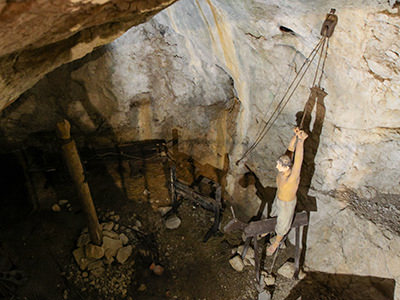
Passing through the castle, and trying to reflect on the life of the days, I was imagining that its darkest corners were not as terrifying. Cold and moist, with moss and mold thriving on its thick rock walls, already the castle itself seemed like a place where living equaled punishment. One didn’t have to end up in a damp prison, or as a trophy on the wall (like horns of hunted deer could testify), to learn that living here was nothing close to a fairytale.
Besides the kitchen, only the master’s bedroom supposedly had a fireplace. The bedroom was connected to the castle chapel by windows, which enabled the master to listen to the word of God from a warm seat. At the same time, the priest had to count on his own fat reserves to warm up, as the large-bellied dummy suggested.
If you think Predjama Castle's dungeon was a scary place for prisoners, wait to see what they do to people in Am Phu Cave, the hell cave of Vietnam!
How to survive a siege in a hanging castle

Predjama Castle armory displayed swords, halberds, battleaxes, flails, shields, and full knight attires. Luka brought me behind the ropes dividing the world of mortal visitors and historical artifacts, and I had the privilege to hold some of the weapons on display. I appreciated the VIP treatment, but it all seemed surprisingly lightweight to me. I imagined that the authentic Middle Ages saw only strongmen becoming knights.
On the top floor, my tour guide showed me the room with murder holes through which the defenders of the castle could pour boiling oil on invaders. Obviously, I wasn’t allowed to try out this line of Predjama Castle defense, nor to use the latrine where the bowels of Erasmus and contemporaries would drop their own set of bombs over a dozen-meter drop.

The castle of Predjama offered splendid views of Vipava Valley, but it was a poor consolation during the time of a siege. Luckily for Erasmus, the secret passage led from Predjama Castle through the cave and out to the other side of the mountain, which essentially secured his survival.
The cave part of the castle was actually the nucleus of its development through the ages. People were living here already in the 9th century, and the add-on of a system of pipes collecting the rainwater enabled the residents to survive during the biggest hardships.
For a modern take on places we live in, visit Vitra Museum in Basel!
Conclusion: Is Predjama Castle worth visiting?
I will not say that Predjama Castle is a great place for history lessons. With a variety of noble families claiming their spot in the world’s largest cave castle, and conflicting political powers fighting for influence on the border between empires, detecting the truth becomes an arduous endeavor.

Maybe that’s exactly the reason why Predjama Castle became a fertile ground for numerous legends, from this and the other world. It feels as if it tried to melt a variety of plots into a single story but paradoxically, still keep it solid.
Its heroes experienced everything from romance to betrayal, from dark ages torture to hunting feasts, from broken skulls to bewitched relics, from confronting the attacker with anecdotal audaciousness to silent tapping in the murky corridors while hiding from the sleepless ghosts of the past.
Predjamski Grad is not exactly on earth, not entirely in the skies, but somewhere in between
Predjama Castle is a Slovenian heritage site that offers a myriad of amusing perspectives, but it definitely charms with the beauty of its architecture that defied the odds of gravity and the ravages of time.
At one of the most unlikely sites to build anything else but a danger-warning signpost, people were determined to construct a gigantic house, not exactly on earth, not entirely in the skies.
Right in between the underworld and the heavens, amidst the hard-working peasant hands below and entitled crowned heads above, Predjama Castle survived for more than eight centuries, as a fascinating monument to human persistence.

Predjama Castle quick facts
How do you pronounce Predjama?
Predjama Castle pronunciation could be a real tongue-twister to non-Slavic speakers. The correct way to pronounce Predjama is [pɾɛdˈjaːma]. If you still need help saying it aloud, find the audio of the pronunciation here.
The name Predjama literally means “in front of the cave”.

Where is Predjama Castle located?
Predjama Castle’s location is in the historical region of Inner Carniola in Slovenia. The mountainside castle is just above the village of Predjama, some 11 kilometers northwest of the town of Postojna.
How do you get to Predjama Castle?
The town of Postojna is easily reachable by bus or train from Ljubljana, but to get all the way to Predjama, using a car or the Postojna Cave Park shuttle bus is the best option.
Alternatively, you could join an organized Predjama Castle tour from Ljubljana, which will take you both to the castle and Postojna Cave in a minivan for 51 Euros. Join the tour here.
If you want to travel from Lake Bled to Predjama Castle, you can join this tour for 79 Euros.
Visiting Predjama Castle from Trieste is possible by joining this tour for 75,31 Euros.
For those of you who wish to visit Predjama Castle from Zagreb, and see Ljubljana and Postojna on the way, the solution is this tour for 120 Euros.
Have in mind that admission ticket to the sites is not included in these tours.

Predjama Castle tickets
Predjama Castle ticket price for adult visitors is 17,50 Euros. Students and children, basically anyone between the age of 6 and 25, have reduced admission to Predjama Castle, at a price of 14 Euros. Children up to 5 years of age pay a symbolic entrance fee; they can witness Predjama Castle for 1 Euro only.
Predjama Castle audio guide comes in 17 languages (Slovenian, Croatian, English, German, Italian, French, Hungarian, Spanish, Portuguese, Dutch, Russian, Polish, Czech, Hebrew, Chinese, Japanese, and Korean), and is included in the ticket price. Alternatively, you can download a free mobile app.
Predjama Castle parking will cost you additional 5 Euros for a day.
Dogs and other pets are not allowed inside Predjama Castle.
The combined ticket to Predjama Castle and Postojna Cave costs 40,90 Euros. If you want to have a full Postojna Cave Park experience (a few more exhibitions included), you will pay 49,50 Euros. If you bought the combo ticket, you can avoid paying for the parking by using the provided shuttle bus between the sites.
Can you see Predjama Castle without paying?
Yes, you can see Predjama Castle without paying, if you don’t wish to enter inside. Visiting the village, and taking Predjama Castle photos from outside is free of charge. If you avoid the opening hours of Predjama Castle, you won’t even have to pay the mandatory parking fee for your vehicle.

Predjama Castle’s opening hours
From November to March, Predjama Castle operates from 10 am to 4 pm. In April and October, the closing time extends to 5 pm.
If you come in the warmer months, between May and September, the opening hours of Predjama Castle will be from 9 am to 6 pm. In July and August, the closing time extends to 7 pm.
Occasionally, on dates such as Halloween, Predjama Castle organizes special night tours.
How much time does it take to visit Predjama Castle?
For a hurryless experience, I would reserve at least 1 to 2 hours for visiting Predjama Castle.
Predjama Castle virtual tour
If you don’t plan to visit Slovenia soon, or you have already visited Predjama Castle but want to refresh your memory, you can also enjoy the virtual tour of the castle, from your home. You can find it here.
Where to stay when visiting Predjama Castle?
There is no hotel in Predjama where you could stay. Your best option is to pick accommodation in the town of Postojna and organize a transfer from there.

Probably the most convenient place to stay is Postojna Cave Hotel Jama. This 4-star hotel is located right in the middle of the Postojna Cave complex, and Predjama Castle is just a shuttle bus ride away. The price could be between 130 and 200 Euros per night, depending on the period. Read my Hotel Jama review first, and then check the prices for your desired dates here.
For a more affordable luxury choice, pick Hotel Kras in the city center. A night in a double room in this 4-star hotel could cost you between 70 and 110 Euros. Check the availability and prices here.
Budget travelers could opt for staying in the Youth Hostel Proteus where a single room can be rented for 29 Euros per night already. Check the availability for your dates here.
Did you like this guide to Predjama Castle?
Pin it for later!
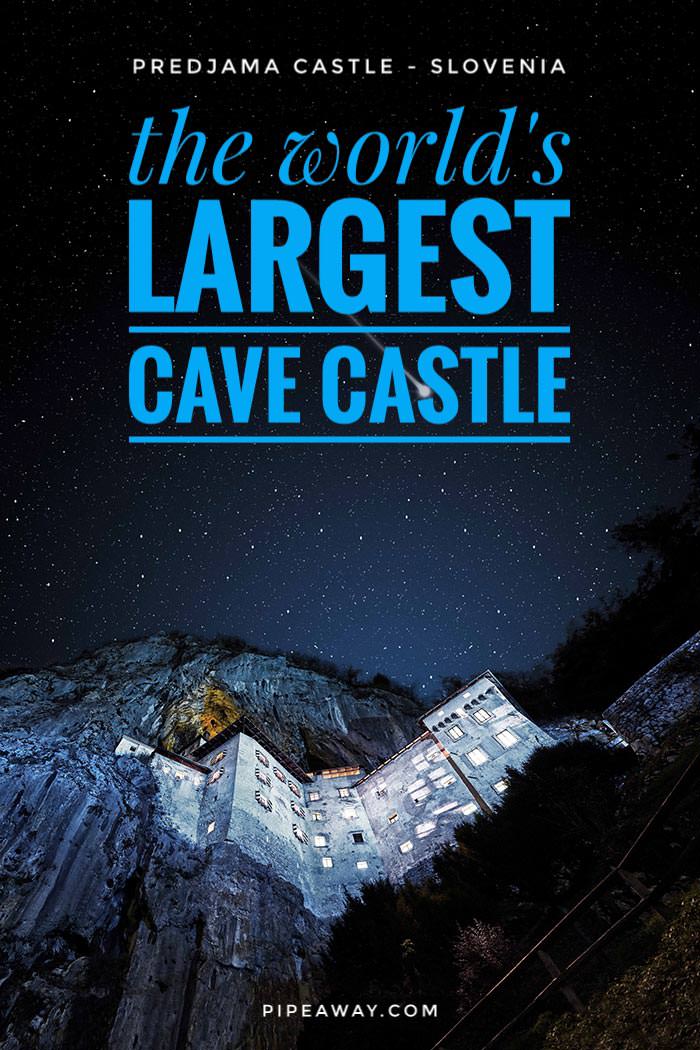
Disclosure: This post may contain affiliate links, which means if you click on them and make a purchase, Pipeaway might make a small commission, at no additional cost to you. Thank you for supporting our work!




I’ve wanted to visit this castle since I saw it on Ghost Hunters International! Hopefully I can make it to Slovenia someday
I’m sure Predjama Castle will wait, and ghosts will still be around 😉
What an amazing place-when I visit Slovenia, this castle will surely be on the list of things to do!
Slovenia is full of magical places, and Predjama Castle is just a tiny tip of an enormous iceberg of surprises hidden in this small country!
When you plan your visit, don’t underestimate the country’s size, and reserve enough time to thoroughly explore it – there will be plenty of things to do and places to visit!
The cruise I’m taking stops in Koper for a day. I’ll have from 8 am til the ship leaves at 10 pm to tour some places. This Predjama castle is on my list but what else do you recommend I schedule while I’m there?
Hi, Caroline!
If you intend to visit Predjama Castle, you should definitely include some more caves in your tour.
The obvious choice is Postojna Cave, home to “living dragons” – https://www.pipeaway.com/postojna-cave-slovenia/
But Škocjan Caves are also on your way from Koper to Predjama – this UNESCO-protected cave system has an impressive underground river canyon.
If you want to explore Slovenia’s nature above the ground, check out Rakov Škocjan Nature Reserve, with nice walking trails and natural bridges.
Of course, if you still have some time left, go exploring Koper Old Town before returning to your cruise ship.
Enjoy your trip, and share your impressions afterward!
Ivan